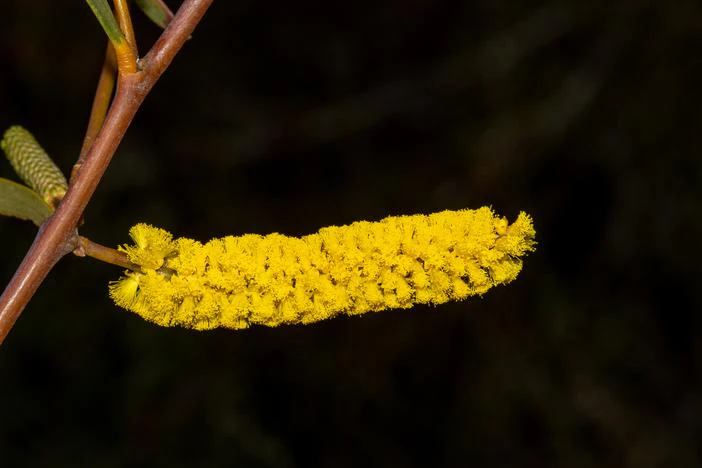Silver Wattle
(Acacia lasiocalyx)
Silver Wattle (Acacia lasiocalyx)
/
/

Tim Hammer
CC BY 4.0
Image By:
Tim Hammer
Recorded By:
Copyright:
CC BY 4.0
Copyright Notice:
Photo by: Tim Hammer | License Type: CC BY 4.0 | License URL: http://creativecommons.org/licenses/by/4.0/ | Occurence ID: https://www.gbif.org/occurrence/4946103738 | Publisher: Inaturalist |














Estimated Native Range
Climate Requirements for La Verne, California
| This Plant | Your Site | Plant Suitability for Your Location | ||
|---|---|---|---|---|
| • Precipitation | 9" - 48" | 17" | Your precipitation may be too high for this plant. | Too high |
| • High Temp. | 74°F - 102°F | 91°F | Your summer temperatures are normal for this plant. | Excellent |
| • Low Temp. | 40°F - 49°F | 40°F | Your winter temperatures are normal for this plant | Excellent |
This plant may not grow well at your location - your precipitation is too high.
Summary
Acacia lasiocalyx, commonly known as Silver Wattle or Shaggy Wattle, is a deciduous shrub or small tree from the genus Acacia within the subgenus Juliflorae. It is native to arid and semi-arid regions, particularly in rocky or sandy soils of Western Australia. Silver Wattle typically grows to a height of 1.5 to 7 meters (5 to 23 ft), with some specimens reaching up to 25 meters in their natural habitat. The plant has a weeping habit with a sparse, open canopy. It produces bright yellow, rod-shaped flower clusters from July to October, which are highly attractive to pollinators. The linear seed pods that follow are distinctive, raised over the seeds, and can be up to 16 centimeters (6.3 in) long.
Silver Wattle is valued for its drought tolerance and ability to thrive in full sun with minimal water requirements, making it suitable for xeriscaping and as an ornamental in dry gardens. Its fast-draining soil preference and low water needs contribute to its ease of maintenance. The plant’s weeping form and vibrant yellow flowers make it a striking addition to landscapes. However, it can be prone to root rot if overwatered or planted in poorly drained soils. In regions outside its native range, care should be taken as it can become invasive.CC BY-SA 4.0
Silver Wattle is valued for its drought tolerance and ability to thrive in full sun with minimal water requirements, making it suitable for xeriscaping and as an ornamental in dry gardens. Its fast-draining soil preference and low water needs contribute to its ease of maintenance. The plant’s weeping form and vibrant yellow flowers make it a striking addition to landscapes. However, it can be prone to root rot if overwatered or planted in poorly drained soils. In regions outside its native range, care should be taken as it can become invasive.CC BY-SA 4.0
Plant Description
- Plant Type: Shrub, Tree
- Height: 6-24 feet
- Width: 6-24 feet
- Growth Rate: Moderate
- Flower Color: Yellow
- Flowering Season: Winter, Spring
- Leaf Retention: Evergreen
Growth Requirements
- Sun: Full Sun
- Water: Low
- Drainage: Medium, Fast
Common Uses
Bee Garden, Bird Garden, Drought Tolerant, Hummingbird Garden, Low Maintenance
Natural Habitat
native to arid and semi-arid regions, particularly in rocky or sandy soils of Western Australia
Other Names
Common Names: Shaggy Wattle, Spearwood
Scientific Names: Acacia lasiocalyx, Racosperma lasiocalyx
GBIF Accepted Name: Acacia lasiocalyx C.R.P.Andrews